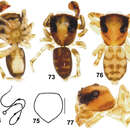Eupoa prima: Brief Summary
provided by wikipedia EN
Eupoa prima is a species of jumping spider from Vietnam. Described in 1985, it was for some time the only described species in the genus Eupoa; however, since 1997 six new species have been reported.
- license
- cc-by-sa-3.0
- copyright
- Wikipedia authors and editors
Description
provided by Zookeys
MALE (the holotype). Measurements. Carapace 1.00 long, 0.89 wide and 0.55 high at PLE. Ocular area 0.64 long, 0.89 wide anteriorly and 0.81 wide posteriorly. Diameter of AME 0.29. Clypeus height 0.06, chelicera length 0.24. Abdomen 0.95 long, 0.61 wide. Length of leg segments: I: 0.54 + 0.26 + 0.34 + 0.36 + 0.19; II: 0.47 + 0.21 + 0.30 + 0.32 + 0.19; III: 0.46 + 0.21 + 0.27 + 0.35 + 0.23; IV: 0.71 + 0.30 + 0.51 + 0.39 + 0.29. Leg spination. Leg I: Tb v 1-1-1; Mt v 2-2-2ap. Leg II: Mt v 1-1-1ap. Leg III: Tb pr and rt 0-1. Leg IV: Tb pr 0-1; Mt pr and rt 1ap, v 0-1-0. Coloration (Figs 72–73, 78–79). Carapace yellow-brown, with a large yellow spot occupying almost the entire eye field; blackened around eyes. Clypeus naked, yellow, with a dark brown marginal line. Sternum, maxillae and labium yellow, tinged with brown. Chelicerae yellow, each with an anterior longitudinal brown stripe. Abdomen: dorsum brown, with shining scutum and a poorly marked yellow spot; sides brown; venter yellow. Book-lung covers yellow. Spinnerets: anterior pair brownish, posterior pair yellow. All legs yellow, but pro- and retrolateral sides of all segments (except for tarsi) brownish. Palps yellow-brown. Palpal structure as in Figs 74, 80–84: femur modified, with a wide proximal-ventral protuberance (as a short apophysis); patella with two apophyses, short basal apophysis and long median one, reaching almost a third of the cymbial lenght; tibial apophysis bi-ramous: its ventral branch wide, massive and visibly sclerotized and its dorsal branch short and cone-shaped; cymbium with triangular lobe in retrobasal part; tegulum well-developed; tegular apophysis situated on the median side of tegulum and directly anteriroly; median apophysis thin and hook-shaped, directed laterad; compound terminal apophysis low and wide, situated at the embolic base; embolus whip-shaped, making one revolution, its tip is resting on the dorsal side of tegular apophysis (its course is shown in Fig. 74).
FEMALE (the paratype). Measurements. Carapace 1.21 long, 1.01 wide and 0.60 high at PLE. Ocular area 0.76 long, 1.07 wide anteriorly and 0.96 wide posteriorly. Diameter of AME 0.36. Clypeus height 0.06, chelicera length 0.29. Abdomen 1.23 long, 0.86 wide. Length of leg segments: I: 0.70 + 0.30 + 0.43 + 0.43 + 0.21; II: 0.57 + 0.28 + 0.33 + 0.37 + 0.23; III: 0.56 + 0.21 + 0.36 + 0.43 + 0.27; IV: 0.89 + 0.29 + 0.64 + 0.56 + 0.31. Leg spination. Leg I: Tb v 2-2-2ap; Mt v 2-2-2ap. Leg II: Tb pr 0-1, v 1-1; Mt v 2-2-2ap. Leg III: Tb pr and rt 0-1-0; Mt pr 1-2ap, rt 2ap, v 1-0. Leg IV: Tb pr and rt 0-1-0, v 1-0; Mt pr 1-2ap, rt 1-1ap, v 1-0. Coloration much lighter than in the male (Figs 75, 77). Carapace yellow, with two wide brown stripes on sides. Blackened around eyes. Clypeus and ‘cheeks’ naked, yellow. Sternum, maxillae, labium and chelicerae yellow. Abdomen: dorsum yellow, with four transverse brown bands; sides yellow, each with a longitudinal brown stripe; venter yellow. Book-lung covers and spinnerets yellow. Legs I yellow, with pro- and retrolateral sides of femora, patellae and tibiae brownish. Legs II-IV yellow, with brownish patches at segment joints. Palps yellows, tinged with brown, but tarsi entirely yellow. Epigyne and vulva as in Żabka (1985: figs 167–169): epigynal plate flat, of the shape of inverted trapezium; paired copulatory openings spaced up; insemination ducts narrow and weakly sclerotized, directed to each other; receptacles sclerotized, bean-shaped.
- license
- cc-by-3.0
- copyright
- Dmitri V. Logunov, Yuri M. Marusik
- bibliographic citation
- Logunov D, Marusik Y (2014) Taxonomic notes on the genus Eupoa Żabka, 1985 (Arachnida, Araneae, Salticidae) ZooKeys 410: 63–93
- author
- Dmitri V. Logunov
- author
- Yuri M. Marusik
Distribution
provided by Zookeys
Southern Viet-Nam (Żabka 1985).
- license
- cc-by-3.0
- copyright
- Dmitri V. Logunov, Yuri M. Marusik
- bibliographic citation
- Logunov D, Marusik Y (2014) Taxonomic notes on the genus Eupoa Żabka, 1985 (Arachnida, Araneae, Salticidae) ZooKeys 410: 63–93
- author
- Dmitri V. Logunov
- author
- Yuri M. Marusik

